Hunter: The Vigil: Tooth and Nail by The Sin of Onan
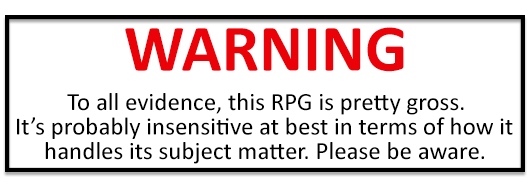
When the Calling Comes
Original SA postJesus Christ this thread moves quickly. Following on from "Heroes who are basically Hunters," it's "Hunters who are actually Hunters."
Hunter: Tooth and Nail – Part One: When the Calling Comes
Everyone in this thread already knows what Beast: the Primordial is – and we are all very big fans – and I'm sure you all know what I'm about to tell you about Hunter, but here is a bit of context for those who, for some reason, might not. Hunter: the Vigil is a Chronicles/New World of Darkness game line about being a (usually) ordinary person who tries to kill, capture, document, study, or protect themselves and others from the various monsters that you play in other lines. Its initial run had three books dealing with hunting the three major lines of the New World of Darkness, or NWoD; Vampire, Mage, and Werewolf, and some other interesting little oddities like Slasher, a book about hunting (or playing as) serial killers with a supernatural bent.
Fairly recently, the second edition of NWoD, Chronicles of Darkness, was released, and along with it a book for Hunter called Mortal Remains. Mortal Remains is a rules update for Chronicles of Darkness, but it also contains rules and organisations for hunting the NWoD game lines that the previous books had not covered; Prometheans, Changelings, Mummies, Sin-Eaters, and Demons. It's a decent enough book. It contains a baffling number of Compacts and Conspiracies (Hunter organisations) devoted to hunting the relatively harmless and not-terribly-interesting-at-least-to-me mummies (two), and an equally baffling number (zero) devoted to hunting the True Fae, the biggest arseholes in a game world not short on giant arseholes, but apart from that I've not looked too closely at it and don't have any major faults to talk about.
One thing you may notice is that Beasts were not on the above list of critters featured in Mortal Remains. This is because Beast: the Primordial was only a fever-dream in the mind of Matthew McFarland when Mortal Remains was released. It was, however, a $93,000 stretch goal for the Beast Kickstarter to have a tie-in supplement to Mortal Remains (itself a supplement, for some interesting supplement recursion) featuring Beasts, which the Kickstarter ended up exceeding by more than $20,000. That supplement, Hunter: the Vigil – Tooth and Nail, dropped a few days back now.
And yes, by saying this, and admitting that I have it, I am admitting that I was one of those people dumb enough to back the Kickstarter. I naively assumed, as Onyx Path were producing good work with lines like Demon, that they would continue to do so, and so backed Beast without really reading much about it. Heaven will judge me for this lapse. This review is a penance of sorts.
With that personal note:
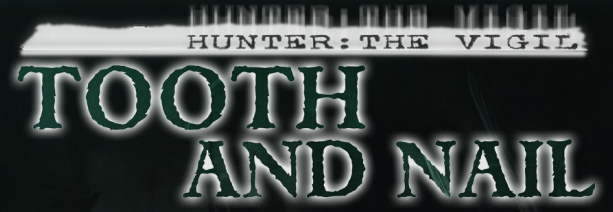
Tooth and Nail is thirty-seven pages long including the various art pages, the not-at-all-superfluous-for-a-PDF title and back pages, and the obligatory intro fiction. It ought to be said that, while it is officially a Hunter book, it makes a certain degree of sense for analysing it to treat it as the first Beast supplement, and that's more-or-less how I'll be reviewing it; as a book effectively in both lines.
The credits page starts out with the following note:

Again, I take my share of the blame for this book. 
Like all NWoD books (possibly all OWoD ones as well; I've never owned any), it opens with a short story to set the mood, When the Calling Comes. We're going to linger on it, because it's offensively stupid, as with most Beast-related things that aren't stupidly offensive. I'm not sure how much of the text I can get away with reproducing and how much counts as  , so this will mostly be a summary with some quotations.
, so this will mostly be a summary with some quotations.
You might expect a story from a supplement on hunting Beasts to contain the act or activity of hunting a Beast. You'd be wrong, idiot. It's not even about people who hunt Beasts. It is actually, as you will see, about a man who killed a Beast but wasn't supposed to, and how he and his partner are punished for it by a group of Hunters.
Let that sink in for a moment.
The story opens with a trope that a lot of RPGs seem to attempt, and one which they never really seem to pull off; the old 'retell a classic/well-known story, but with a shocking twist that changes the theme.' They did it for that Scorpion clan-book for Rokugan; I only know this from the excellent F&F review, and I found what they did to an innocent Aesop fable shocking alright, but not for the reasons the writer presumably wanted. White Wolf themselves did it in the NWoD book Inferno, all about demons (in the classic 'hell-spawned monsters that feed on human sin' mould, not the Cold War-esque renegade angels from the God-Machine of the game line Demon: the Descent), riffing on 'Footprints,' a short story about God and a man walking down a beach with which I'm sure you're familiar, if (in a personal digression) you have the kind of relatives who know you're not religious but buy you a new Bible every birthday anyway. That one kind of worked, but not well.
This one just puzzles me. It's another story about God and a man, which I've heard before but don't know the name of. The setting is a church, with a priest (Brother Devon) delivering this as part of a sermon.
quote:
“Man’s stranded on an island. A boat comes by and offers to take him away. He says thanks, but I prayed, and God’s gonna come save me.” The crowd trail him with its [sic; also WoD editing is rather hit-and-miss, by the way] eyes, through every twist and turn. Brother Devon spoke with a slow, folksy, rhythmic drawl, almost hypnotic.
“Then a prop plane lands on the island. They offer him a seat when they leave. He says thanks, but I prayed, and God’s gonna come save me.” The people look amongst each other, nodding, listening along.
“Weeks pass. He runs out of food. He cries out to God. Asks why he’s been forsaken. God parts the heavens, and says I sent ya a boat, and I sent ya a plane. What else do you want from me? And you know what happened next?”
The crowd is treating this as a rather more riveting story than it is, “through every twist and turn,” even though the story says in the next paragraph after the ones I've quoted that “Even the children knew how the tale ended.” The thing is, in most versions of the story that I've heard, the story ends there. God comes down and points the obvious out to the man. We learn that God moves in mysterious ways and that, if he wants to help you, he won't come down in a blast of trumpets to fix everything; he'll send you an opportunity, which you have to take. The story doesn't linger on what happens to the man.
Devon doesn't finish the story here. He clarifies that the man dies, “because God answered, but he didn't listen back,” and then chastises his flock for not listening to the signs that God is sending them. That is the twist ending, and it's really just an explanation of the story, with added gory detail. It's really just an extended segue into the actual action of the story. Why am I talking about it in such depth, then? Because it takes up a third of the intro fiction and it's pointless. It is exactly as pointless as I have made it sound, and neither makes you re-evaluate the original story nor adds any value to When the Calling Comes. Why it is here, in the book of a company that I know cares quite a bit about page count, is baffling, especially as there are some rather weird omissions later in the book that could probably have used some extra words.
He singles out a particular woman in the crowd, Sister Miriam, and her partner, as having not listened for God's signs. Miriam's partner Zeke is “sweating bullets,” and is obviously guilty of something, but Devon decides to interrogate her instead. She initially assumes it's about the fact that she's together with Zeke without being married, but Devon makes it clear that it's actually about Zeke, not her. Miriam confronts Zeke, angry and in tears, and Zeke breaks down and admits his sin; he killed a Beast. In a book about killing Beasts.
Reading further into Tooth and Nail, these guys are obviously one of the new Compacts, the Reckoners. We'll talk more about them later, but the thing about the Reckoners that makes them special, and stupid, is that they don't hunt Beasts. They hunt Heroes, supposedly because Heroes do more collateral damage, kill more civilians than the Beasts they're trying to kill. Zeke makes it clear that the Beast he killed was itself killing people (and is therefore exactly the kind of monster that a Hunter would be entirely justified in killing), but Miriam treats him as if he was the one murdering innocents, as if he will progress to murdering innocents; in short, as if he were exactly what Beast the game line wants you to believe a Hero is. You see, there is almost as much space in this book devoted to hunting Heroes as there is to hunting Beasts – mechanics for Heroes, Dread Powers for Heroes, Compacts that hunt Heroes. This book is as much a Hero-hunting book as a Beast-hunting book, and where parts of it actually treat Heroes like the survivors that they are, indeed as a sort of Hunter or a somewhat dangerous ally to Hunters (due, I assume, to the influence of Monica Valentinelli, the Hunter Designer named in the credits), the book takes a very McFarland approach to them in many places, as you probably won't be surprised to hear. If it sounds weird that a book about Hunters, the people who seek out and kill various supernatural creatures for various reasons, has space for Hunters who kill Heroes, the people who seek out and kill very specific supernatural creatures for very specific reasons... it is. There is no answer to that.
The story implies pretty heavily that Zeke is a budding Hero; he even claims to have received a calling from God to kill the Beast. Devon argues that the call was in fact from the devil, and gives Miriam a gun to kill her partner with. He tells Miriam that he's making her kill Zeke as part of a genuine calling from God, in a convoluted series of phone-related metaphors involving him repeating the phrase “Ring. Ring.” It is as dumb as it sounds.
Devon posted:
God don't leave a voicemail.
Dumb.
So Miriam insists Zeke can be redeemed, he can repent. What he is repenting of is a bit of a mystery; when we reach the Reckoners, we will see that they don't have a very clear ideology as laid out in the book, and that, while they primarily target Heroes, there's really nothing in their entry that says killing Beasts is even a sin. In fact, there's a bit saying that they explicitly kill Beasts from time to time “out of necessity, defence, or tactical reasons,” which sounds like pretty good grounds to get poor old Zeke off the hook, since the Beast he killed was fucking murdering people.
Miriam is furious, but ultimately can't kill her lover. Devon doesn't like this, and neither does the rest of the congregation.
quote:
“He can do better! He can repent!” She snapped to Devon, but with the gun still at Zeke’s head.
“Ring. Ring.” Devon repeated.
“Damn it!” She snapped, and dropped the gun. “I can’t. We can’t. When do we have to call ourselves the monsters, Brother Devon?” She bounded forward, kneeling and wrapping Zeke in an embrace. “We’ve got to give chances, or we won’t make it to see the end.”
Devon stepped back, receding into the crowd. “We’re sorry. We can’t come to the phone right now. Please leave a message...” [still dumb]
The deafening crack of a pistol pierced the room. Miriam held tight to Zeke, crying openly. Her white shirt revealed a gaping, red hole. Zeke pulled closer. His back - revealed a similar but larger hole; it pierced through the both of them.
Then another crack.
Then another.
Then another.
End scene.
For a game that's all about how evil jocks and trolls are, Beast is remarkably hostile to intellectual analysis and rational thought. Like most of the core Beast book's fiction, When the Calling Comes is thematically incoherent, poorly written, and kind of repugnant. Much of it is superfluous, the metaphors only make Devon look like an idiot, and it ends with the spectacle of the congregation killing a couple for no real reason.
Having just finished reading the Tradition Book: Hollow Ones F&F, I am now aware of the notion of the Chupp Test, an informal test that White Wolf at least used to run their splatbooks through, which Halloween Jack summed up as “Does the book make you want to play Splat X, even if you didn't before?” If Tooth and Nail is a splatbook, and in a way it is, does the intro fiction make you want to play a Hunter who hunts Beasts or Heroes – a Hunter who engages with any of the material in this book? Arguably two instances of hunting occur in When the Calling Comes; Zeke killing the Beast, and the congregation killing Zeke and Miriam because Zeke might be a Hero. The more interesting and sympathetic one happens off-screen, and we don't get to see any of the details that made Zeke do what he did. Was he threatened directly, and fought back in self-defence? Was he standing up to defend the innocents the Beast was killing? Did he feel the call to glory that Heroes supposedly feel? Was it secretly just for the glory of the kill, or some other selfish motive? We don't see his action, so it's not really interesting or exciting; it doesn't feel like a motivator to be a Hunter, because we only know in broad terms what he did or why. This leaves the congregation killing Zeke and Miriam. Zeke, who kills the Beast that's murdering innocents, and Miriam, who stands up to her cult leader (which is what Devon is, come on) and refuses to kill her partner for this “crime,” are the sympathetic characters – I'd be amazed if even the authors meant Devon and the congregation as such – and they both get shafted pretty badly. Are we meant to relate to the congregation as one of them, neither named nor described, shoots this young couple? They're a faceless crowd; their only real viewpoint character is Devon himself, and Devon is a cult leader who plainly rules through charisma (not really shown in the story) and fear. Notwithstanding that Zeke's crime isn't a crime by Hunter's standards – it's more the point and purpose of the entire game line – Devon and the congregation naysay the idea of redemption for a human and kill him and his blameless partner, effectively in defence of monsters. Not only is that not sympathetic, it runs against the whole idea behind Hunter: the Vigil. So it's hardly a motivator to play someone like Devon either. We know (or rather presume; given Beast's general moral orientation, this might not be as obvious as it seems to me) that Zeke and Miriam are sympathetic, Devon and the congregation not, but the text gives no reason or incentive to play as either of them.
Does this story make you want to use the book's content?
Next time: Onan stops jerking off about the opening fiction and actually discusses some of the content of the book, fucking hell
Gaslighting the Reader
Original SA postSirPhoebos posted:
I think at this point we have to seriously consider whether McFarland is gaslighting readers.

Hunter: Tooth and Nail – Part Two: Gaslighting the Reader
So now we have the intro fiction out of the way, I can show you the cover art!
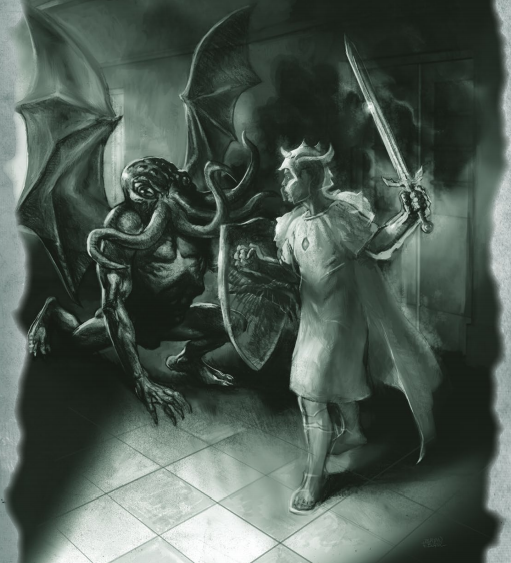
Discount Cthulhu fighting a Hunter in a hospital. I think they're meant to be from the last Compact in the book, the Merrick Institute, so that makes this a dream hospital
 The point is that the art sucks. The Hunter's expression is one of mild surprise and concern, and the poses are extremely stiff and have no action lines. It's not very good. You can see the outline of Cthulhu's dong, though, if you're interested. You weirdo.
The point is that the art sucks. The Hunter's expression is one of mild surprise and concern, and the poses are extremely stiff and have no action lines. It's not very good. You can see the outline of Cthulhu's dong, though, if you're interested. You weirdo.In as far as the book is divided into sections, it has the fluff up front, the crunch in the middle, and the new Compacts at the back. Most of this part is going to be about the fluff, and the first part of the fluff section is all about what Beasts really are.
Something to note is that the three Hunter books dealing with Vampires, Werewolves/Spirits, and Mages – Night Stalkers, Spirit Slayers, and Witch Finders – were very much toolboxes that you could use to construct whatever kind of vampire, werewolf, or magician you wanted for your game. Vampire: the Requiem Vampires aren't repelled by holy symbols, and Werewolf: the Forsaken Werewolves don't spread their condition by biting humans, but the books weren't necessarily detailing the Vampires and Werewolves from the official game lines, and you could easily make a vampire or werewolf who had those traits and weaknesses if you wanted to, with the books' support and blessing.
Tooth and Nail is not like that. For all that it and the Beast core book claim that Beasts represent some sort of universal archetype in the human consciousness, Tooth and Nail has to spend quite a lot of space explaining to you, very specifically and in a manner that brooks no argument, exactly what a Beast is and what they do. This is emphatically not a 'design your own Beast' book; if you want to try to use this book to create a kraken or dragon that's a kraken or dragon in the real world (not just the spirit of a monster hanging out in some poor schmuck's head), or a Beast that just fucking eats people like a good monster, instead of trying half-heartedly to teach some hinky lesson to humans about the nature of fear or something, you're looking in the wrong place. You could use some of the mechanics in this book to represent a monster like that, but unlike with the three Hunter books I mentioned above, this book has a very clear idea of what a Beast is, and doesn't offer any kind of support for deviating from this idea. If you want your Hunters to just go on a trip to Crete to kill the offspring of the Minotaur, you'd probably be better off using different NWoD books, like Predators from Werewolf or something, or even just the basic monster making rules and Dread Powers from the Chronicles of Darkness core book.
So what is a Beast, then? You can find out in depth in Kurieg's Beast: the Primordial F&F, because Tooth and Nail presents basically the same information. Just be sure to heed that content warning, though. Beasts have monster souls made from nightmare-stuff, but they look human; they have powers based largely on fear; they are defined by a specific sort of hunger, that's individual to each Beast; they have lairs, which are somewhat psychoreactive and are coloured by the nature of the strongest Beast (or other supernatural entity) in the area, and you have to destroy the lair to actually permanently kill the Beast; they think of all the other monsters, weirdoes, and assorted supernatural flotsam and jetsam of the World of Darkness as “one huge family, with Beasts at the centre.” The section that talks about family is interesting, actually; although there's nothing inherently supernatural about most Hunters, many Beasts apparently think of Hunters as kin too, and while “even the most jaded Beast can at least understand why hunters take up the Vigil,” they regard the profit- or pleasure-motivated actions of groups like Cheiron or Ashwood Abbey as betrayal of one's family. Why Hunters, who as I said are mostly just ordinary people, are seen by Beasts as family is a mystery, but probably not an intentional one on the part of the designers. As you'll see later, the group that gets singled out most for the "We Are Family" treatment is the Lucifuge (aka the Conspiracy of people descended from Demons), which makes no sense given how Beasts react to Demons themselves, but that's a subject we'll tackle when we get to it.
This section also assumes a lot about the nature of Beasts in relation to the human world, especially the conceit that, compared to other types of monsters, Beasts are actually kind of harmless. We know this to be quite false, but Tooth and Nail makes quite some hay with the idea that Beasts aren't inherently violent, Beasts are victims, anything that a Beast does to harm you is either to teach you a lesson or because you wronged it or the broader supernatural “family” in some way. Almost all of the examples in this book where a Beast harms someone are because they harmed the Beast first. The Beast that Zeke killed offscreen in When The Calling Comes, the one that's murdering people, is a rarity; the other example of a Beast that the book acknowledges is just hurting people is in the background fluff for one of the three Compacts, Yuri's Group. The rest of the book treats Beasts as a moral grey area, terrifying but not actually harmful, even when previous sections will blithely say things like “A person who loses a hand to a Beast’s nightmarish hellscape is just as crippled as a person who lost a hand in a tractor accident. Sometimes his hand might still be there, but something in the brain disallows movement,” as if losing the ability to use a hand isn't major harm, or talks about Beasts clawing someone's face off as “a means of terrorising victims.”
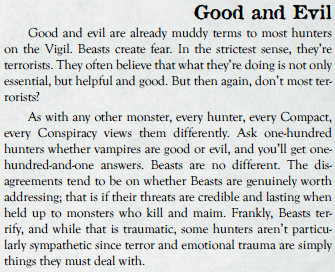
A lot goes into presenting Beasts as the moral grey area here, and humanity as the real villains????, which seems a poor approach to a book that is supposed to be presenting Beasts as something for Hunters to go after. Luckily, Tooth and Nail has a more villainous group for you to hunt, whom I've been avoiding mentioning up till now even through elements of their description are mixed in among the bits describing Beasts throughout this whole section. In fact they get a prize paragraph on the very first non-fluff-or-credits page of the book, before we get all but the most vague description of what a Beast actually is or what they do. Here it is:
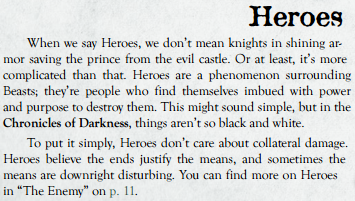
For all that this description uses the words “things aren't so black-and-white,” the language it's using to describe Heroes is way harsher than that which it's been using to describe Beasts so far, or indeed that Tooth and Nail will use to describe Beasts throughout this whole section. In the “About Heroes” section on page 9, they are compared to governments who sanction torture:
quote:
Heroes, by virtue of being Heroes, can do no wrong. Heroes internalize this, and it reinforces their darkest traits. This is a world where people redefine torture to excuse their governments’ behavior – clearly, their elected officials are not monsters who torture people. The truth is more complicated than that rationalization, but it’s also far less comfortable.
We will see similar comparisons and language later on in the book as well. Again, this language and these metaphors are way more extreme than anything that's being used to describe Beasts. Tooth and Nail is not holding back here on wanting the reader to see Heroes as gung-ho, egotistical, and dangerous to everyone around them, more so than Beasts. It sets this up as a moral dichotomy, with Beasts being less human but Heroes being more destructive. Who is the real enemy, you Hunters? The thing is, if one assumes that Tooth and Nail's target audience is Hunter players who might not own or have ever read Beast: the Primordial, it almost works in this book, entirely because no individual Beast ever gets a write-up of any kind in this book, and nor do any Heroes. You don't get to see how horribly self-absorbed and carelessly destructive to human lives, sanity, and wellbeing individual Beasts as written up in Beast: the Primordial are, so you don't get the sense that all Beasts are (unintentionally) written as being actually humungous dickbags; nor do you get to see how individual Heroes are written up as pretty much always the specific victims of horrible Beast fuckery, and mostly after pretty well-justified revenge (that Heroes are basically Hunters, in other words), so you don't get to see how Heroes in practice usually wind up (again, unintentionally) being far more sympathetic than Beasts.
This is a theme you will note throughout this book. It gives the impression of not really being written as a book for Hunters who want to fight Beasts; sticking to Beast's crossover party theme, it's a book for Hunters who want to team up with Beasts, specifically to fight Heroes.
Anyway, Heroes. This section mentions that Heroes are sort-of made by Beasts (or is it the other way around? Dun-dun duuuun), but it's extremely coy as to how that happens; only a careful reading of some of the later stuff, in the crunch section, would reveal to a reader who's not familiar with Beast: the Primordial that Heroes are created as victims of Beast predation. The fluff section doesn't mention this at all. It's almost like the writers realised that putting that rather important information in might make Beasts look bad to someone who hasn't already bought the premise of Beast! But that's just crazy talk, obviously.
The Heroes section on page 11 (I told you the Hero write-up was dispersed; you need to do a lot of paging back-and-forth to get all the information here) emphasises that they are egotists who believe themselves the centre of their own personal epic, and they have a sense of being “alone and unique in persecution, in their ability, and in willingness to take the fight to the monsters.”
quote:
To the reader of a Hunter: The Vigil book, this idea should be laughable. But to the Hero, it’s the only possible logic.
The write-up seems very much designed to discourage Hunters from working together with Heroes, even though it also says that the Hero rules as presented in Tooth and Nail have been tweaked significantly from those in the Beast core book “to give disproportionate attention to rules that would facilitate engagement with hunters.”
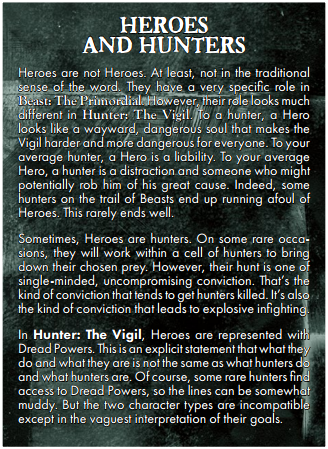
I wonder why it is that Hunters aren't meant to be working with Heroes in a crossover-type situation, even though they both theoretically have the same goals. Surely it cannot be because the writers actually want us to be working with cool, sexy, misunderstood Beasts, instead of mean, dumb, probably sports-playing Heroes?

There is also some discussion of Anathemata (I didn't learn ancient Greek just to sit on my hands while someone treats “Anathema” as both a singular and a plural noun. It's singular only; deal with it), the powers Heroes have to weaken Beasts, and how they can only use them on Beasts who aren't currently raging monsters, but are content and well-fed.
quote:
This often means that Heroes must strike hardest against Beasts causing the least immediate harm. This isn’t too challenging for the Hero – he’s already rationalized everything he’s doing.
See what I mean about Beasts always being presented as the victims? And Hunters as the abusers? I genuinely think the target audience for this book is Hunter players and STs who haven't played/read Beast and don't know better, but if it is meant for people familiar with Beast... yeah, SirPhoebos was right. This is 100% trying to gaslight the reader.
At the end there's also the same note that appeared in the revised Beast: the Primordial about how some Heroes don't hunt Beasts but do other things. This makes no sense as Heroes are created by Beasts and the principle that creates them supposedly explicitly drives them to kill Beasts, but whatever. We won't touch that one.
There's also some stuff about Nightmares and what happens when you die in a dream (spoilers; you don't actually die for reeeeal, Morty, but you can get pretty fucked up and you do lose most of your Willpower). It's not very interesting. You use ghost/spirit rules (so three stats not nine, etc.) and some of the damage you take crosses over when you wake up, downgraded by one level – so aggravated damage becomes lethal, lethal becomes bashing, bashing is ignored. Conditions like Arm Wrack don't follow you back into the real world, though, so that thing the book said earlier about how if a Beast bites your hand off in a dream, you lose the ability to use that hand? Kiiiinda not true, whoops. The book advises you to use Beast: the Primordial and, hilariously, Mage: the Awakening if you want more information on dream rules and the dreaming world, even though some of this stuff outright contradicts Mage's rules about being hurt or killed in the Astral Realms.
This entry was originally going to include all of the fluff, but altogether it is probably too long, so I had to cut the second part about how the Compacts and Conspiracies see Beasts for now. Tune in next entry for America's favourite new game show, Hunter: the Vigil Compacts and Conspiracies: What Do They Know [About Beasts]? Do They Know Things? Let's Find Out!
(Cheiron
 )
)
Compacts and Conspiracies: What Do They Know [About Beasts]? Do They Know Things? Let's Find Out!
Original SA postI Am Just a Box posted:
Re: Beast...
Well, there's not really anything left to be said, is there.

Hunter: Tooth and Nail – Part Three: Hunter: the Vigil Compacts and Conspiracies: What Do They Know [About Beasts]? Do They Know Things? Let's Find Out!
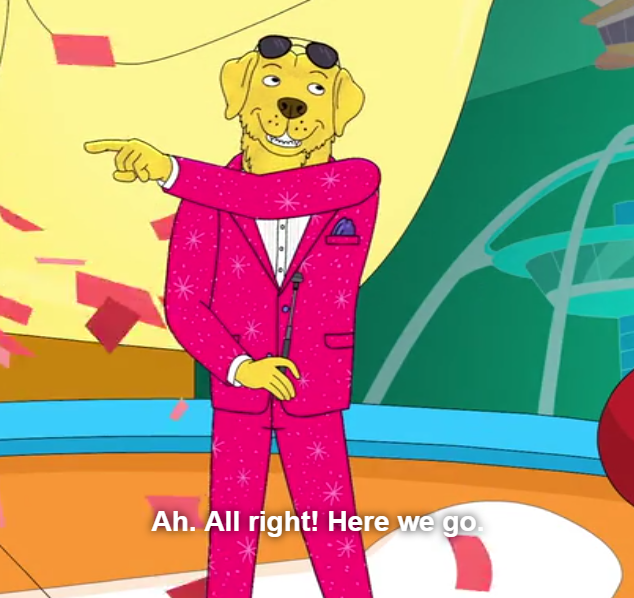
Fair warning: the beginning and end of this entry are extremely referential of Bojack Horseman. Cynical cartoons about a depressed, terrible horse man were a great help keeping me sane while writing all this. If that's not your thing, I am truly sorry.
Or H:tVCaC:WDTK[AB]?DTKT?LFO! for short. This section is basically your bog-standard list of all the Hunter organisations (from the Hunter core book only, sorry VASCU fans) and what they know/think about/do with Beasts. It's also your first introduction to the three new Compacts Tooth and Nail presents, those being Yuri's Group, the Reckoners, and the Merrick Institute. It seems like odd formatting that we're learning about how these three organisations hunt before we learn what they are, what they believe, or what they do, but I'm not an editor, so really, what do I know?
These sections are all written in-character, from the perspective of a member of each organisation, and assume that the member has a certain amount of knowledge about Beasts.
Aegis kai Doru: Some stuff about how many of the great artefacts of history and legend no longer really exist in the real world, but you can find them in dreeeeeams, man; specifically mentioned is Excalibur, apparently “hidden away in the hoard of a nightmarish dragon.” Aegis kai Doru are after it, of course. But if the physical object doesn't exist, I don't know why it matters where the dream object is. Surely a dream object can be anywhere you want? Or anywhere where the idea of its existence is appropriate, at least? Just get a mage to take you to the concept realm of Arthurian legend in the Temenos, dude. Probably less work and less chance of being burned to death.
Ascending Ones: Again, this is mostly about dreams, and using concoctions to explore dream space. Apparently some Ascending Ones have figured out how to use potions to meet up in dreams, and all the cool Ascending Ones hang out there now. It's kind of a neat idea. The PoV Ascending One admits Beasts themselves are a secondary concern, and the Conspiracy mostly leaves them to their own devices, but they act very quickly to destroy the ones that are already violent enough that they might attack when a bunch of Ascending Ones go day-tripping in Astral Space. Seems reasonable.
Ashwood Abbey: Have you ever fucked a man who caused the world's most famous maritime disaster?
quote:
Let me start off by saying something provocative, to perpetuate the myth that “The Ashwood Abbey are the real monsters.” Let’s see. Where do we start?
Oh. Did you know that both fear and arousal are dictated by the same chemicals in the brain? Chemically-speaking, being afraid and being turned on are almost identical. So, what’s hotter than hunting nightmares made flesh?
Now that we’ve got that silly shit out of the way…
Thanks, Ashwood Abbey guy!

So as we established earlier, Beasts don't like Ashwood Abbey; they've no problem with a Beast who sunk the Titanic and killed well over a thousand people (
 ), not to mention murdered dozens if not hundreds of other people in maritime or swimming accidents, but when a bunch of strangers on heavy drugs show up and try to kill, eat, and/or have sex with the monster that sunk the Titanic, that's crossing a line. Apparently there is at least one chapter of Ashwood Abbey that likes to hold big hunts for Beasts in the dream world; the other Ashwoodites don't approve of them, because it's too dangerous (not like everything else the Abbey does, or like that's the point of half of what the Abbey does) and because the Beasts will hunt you down for doing it, despite being one of the least organised – and therefore least capable of organised revenge – monster splats in NWoD. Seriously, if you're not worried about werewolves, mages, changelings, or other supernaturals that actually have societies and/or a sense of personal loyalty to others coming and wrecking your shit for messing with their fellows, why you're so worried about Beasts is beyond me.
), not to mention murdered dozens if not hundreds of other people in maritime or swimming accidents, but when a bunch of strangers on heavy drugs show up and try to kill, eat, and/or have sex with the monster that sunk the Titanic, that's crossing a line. Apparently there is at least one chapter of Ashwood Abbey that likes to hold big hunts for Beasts in the dream world; the other Ashwoodites don't approve of them, because it's too dangerous (not like everything else the Abbey does, or like that's the point of half of what the Abbey does) and because the Beasts will hunt you down for doing it, despite being one of the least organised – and therefore least capable of organised revenge – monster splats in NWoD. Seriously, if you're not worried about werewolves, mages, changelings, or other supernaturals that actually have societies and/or a sense of personal loyalty to others coming and wrecking your shit for messing with their fellows, why you're so worried about Beasts is beyond me.The Cheiron Group: I'm just going to post the whole text of this from the book, because it's fantastic:
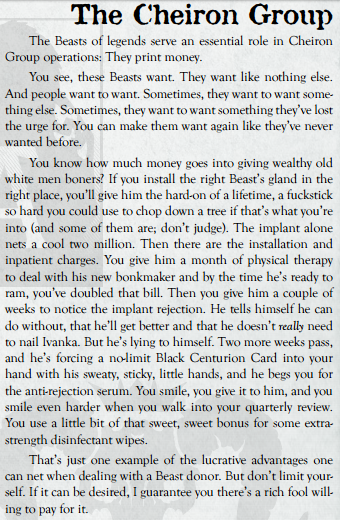
So Cheiron's interest in Beasts, as you might expect, is entirely in chopping them up and selling their bits for money. So far so normal, but they pretty much state outright that what they do with Beasts is grind them up and inject them into, specifically, Donald Trump's orange penis. It's nuts, and it's one of the few things in this book that's actually worth the price of admission.
Cheiron

The historical Cheiron was a Beast (of sorts) who was a teacher of Heroes. I was kind of expecting them to do something with that, given the Cheiron Group's weird past and its archery logo, but they don't. I'm not disappointed, because what we got was incredible, HOLY SHIT, but it still seems like it could have been interesting ground to tread.
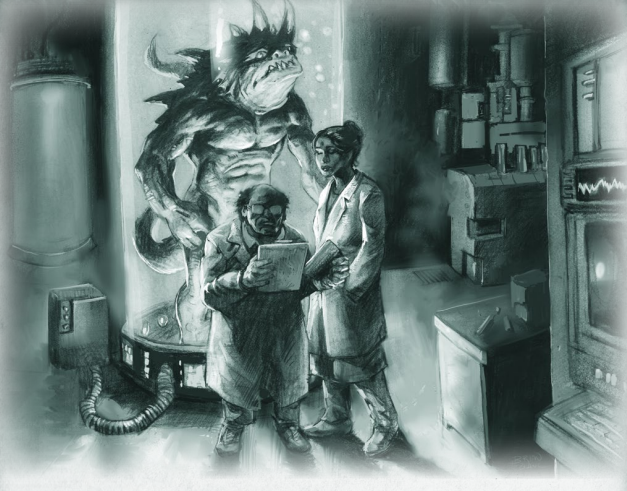
The one relatable Beast I've seen so far in the whole game line. That is the exact expression I'd have if I knew the weird lumpy scientists were going to turn me into powder and stick me in Trump's Li'l Donny.
The Lucifuge: So the Lucifuge have noticed this thing Beasts have about being kin, and all the expectations that Beasts will project onto them because of this.
quote:
Let’s just make this clear: We have no idea what in the hell they’re talking about, and we have no evidence whatsoever that we’re related to them.
Apparently Beasts singling out Lucifuge Hunters as family is more-or-less special to Lucifuge; they don't so much do it to other Hunters. This is weird, because the Lucifuge's backstory is pretty clear on the fact that they're descended from or somehow related to demons, and about the only supernaturals that Beasts explicitly DON'T get along with or regard as kin are Demons. Maybe Lucifuge demons and Demon Demons are different? There certainly are a lot of entities in NWoD called “demons,” so it's possible... except the writeup that Demons get in the Mortal Remains book proper implies that a) there's not a huge difference between the Demons of Demon and the demons of Inferno, and b) the Demons the Lucifuge deal with, the ones they claim to be related to, are pretty clearly the ex-servitors of the God-Machine. So why do members of the Lucifuge trip Beasts' family-senses, while actual Demons do not?

Fortunately, the Lucifuge are pretty no-nonsense about that shit. They see the terror and trauma that Beasts cause, and react accordingly, by killing them. The Lucifuge perspective-person even says they think Beasts are worse than Vampires; a Vampire can feed on livestock if they so choose, but a Beast can only survive by terrorising human beings. Better to kill Beasts than leave them to wreck lives and degrade the fabric of society.
quote:
Very few of them are worth saving.
It's nice that the Lucifuge have their heads on straight on this one.
The Long Night: The Long Night are also pretty sane on this matter, surprisingly. Their stance is basically that of the Reckoners, if the Reckoners' stance actually made sense: the Beasts are the Beasts of Revelation. They are God's greatest foes on Earth. When the Long Night learns of the existence of a Beast, “they must become our first priorities.” The Long Night's goal with Beasts is to kill them, hard, and make sure groups they might ally with out of convenience (like Cheiron or the Ascending Ones) don't do any freaky shit with the bodies.
quote:
We cannot allow scraps of their bodies to spread damnation. We read ahead to the end of the book. We know what happens.
The Beast must be destroyed in toto. Again, I approve.
Loyalists of Thule: The Thule Society is, naturally, largely interested in researching Beasts. They too have noticed the Beasts' kin-sense thing, and are trying to study it. One of them, a Doctor Hans Voorman, is apparently trying to reach out to Beasts to live with and learn more about them; the Thule perspective-person name-drops Jane Goodall here as an example of scientists doing this with other creatures. It's a fun idea. Most Beasts haven't shown much interest. One apparently will only accept if the Hunter living with them is from Lucifuge, which brings us back to the weirdness of why Beasts are so attracted to Lucifuge members but not to Demons. This is all fairly normal and relatively sane stuff for the Loyalists of Thule, although the perspective-person mentions that the damage Beasts cause “tends to be localized and relatively nonlethal when held up in comparison with other, more common manifestations of the darkness.” Sure, buddy.
Malleus Maleficarum: Their basic perspective is that Beasts aren't very common and the Church has bigger fish to fry. This is the shortest of all the Compacts and Conspiracies entries, and it's largely interesting because it's the first time Heroes get mentioned in these descriptions, although the word “hero” is not specifically used.
quote:
In all truth, it appears most of the real risk in these monsters comes from humans poking the proverbial hornets’ nest. Humans cannot leave well enough alone, and when they hear of legendary monsters, they seek to kill legendary monsters. Everyone wants to be Saint George. Most end up John Doe.
It's a reasonable enough stance. It misses the fact that Heroes are created by the actions of Beasts, and that they are supernaturally compelled to hunt Beasts, but it's plausible that the Malleus Maleficarum might not actually know those details. If they did, I expect their view might be different.
Also, I keep finding it slightly jarring that this book keeps mentioning Saint George as an example of a Hero, when there's a whole Conspiracy in Witch Finders that takes their name from Saint George and are really far worse for the universe at large than Heroes. Anyone else find that weird? Maybe that's just me.
Network Zero: Network Zero's writeup is about Heroes almost to the exclusion of Beasts, although, again, the word “hero” is never used. Beasts, according to the Network Zero perspective person, basically make for great filming and fun videos that get a lot of views. Kind of a sadistic perspective, but okay. Trouble is, these videos also sometimes create Heroes out of the people that watch them. Not “create Hunters,” which the PoV person says is a normal and pretty understandable reaction to watching a video of a vampire killing and eating someone, but actual Heroes.
quote:
These people aren’t hunters. Not like us. They’re… Different. It’s like they’re supernaturally emboldened to hunt. They just go fucking bonkers about it. You know the worst, most ridiculous and uncompromising hunter you’ve ever met? They’re all that guy.
Now I'm pretty sure this goes against Beast's own word on how Heroes actually get made, but whatever. The PoV person takes this as a lesson that they should be careful about where and how widely they distribute some of the things they see, and muses that maybe Heroes are not normal humans but their own kind of monster. Should the Network be sharing information on Heroes, or letting them do their thing?
Null Mysteriis: Null Mysteriis' entry reads like it was written by someone who was very tired of Beasts and their shit, and wanted to smack down most of their pretensions. Much like Cheiron's, I'm going to reproduce it here:
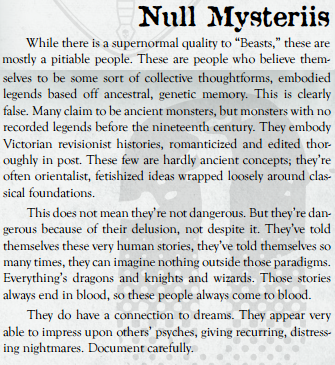
It's a pretty good takedown of much of the concept of Beasts. For all that they claim to be based on ancient archetypes, a lot of the Beasts in Beast: the Primordial are very pop-culture indeed. Their archetypes are also vague and ill-thought-out, but that's a bit off-topic. The PoV person advances the interesting idea that Beasts trail such violence with them wherever they go because they reify the violent stories in their heads; that they create Heroes (which we know, as does Beast: the Primordial) and that this is their own fault for being so trapped in these narratives of violence that they can't help but further them by their actions (which Beast: the Primordial doesn't want you to think at all – it wants to convince you that Beasts are the victims of Hero violence, not the cause – but which dovetails nicely with this thread and others' observations that Beasts deserve the revenge that the Heroes, created by Beast actions, bring down on them).
The Null Mysteriis entry was almost certainly written by someone who had the same reaction to Beasts and Heroes that we have. It doesn't have the sheer hilarity of Cheiron selling boner pills made of melted-down Beast to Trump, but of all the ones in this list, Null Mysteriis' entry is probably my favourite. As a humanities student myself, it pleases me mightily to see someone in-game attacking the shitty themes and poor conceptual design of Beast. It's vindicating.
Task Force: Valkyrie: Another short entry. TF:V's entry is one soldier to another, probably an instructor to a recruit, and entirely about how dangerous Beasts are when you're ordered to kill them. It doesn't spend much time discussing questions of why?” or “is it moral to kill Beasts?” It's practical advice that someone fighting a Beast might need. Don't hesitate. Don't hold back. Bring everything you've got. Do not go in their lairs. The only space it devotes to the moral aspect of hunting Beasts is one sentence: “The work is absolutely necessary.” Says all it needs to, I think.
The Union: I actually forgot this entry had a specific example of a Beast explicitly doing bad shit, so bump the number of examples in the book up to three. The Union's problem with Beasts is both moral and philosophical. The Union wants safe and functioning communities in which people co-operate and look out for each other. I agree, and I find a lot of what the Union PoV person is saying resonates with me, so you can see the whole thing:
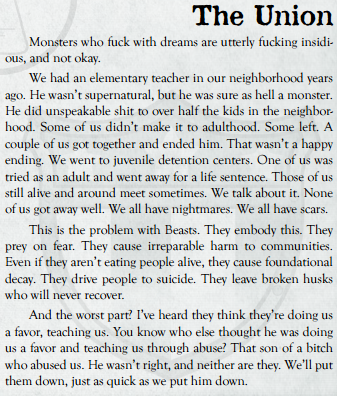
It embodies most of what is shitty about Beasts. The way they kill people, of course, but also the way they break people, get into your head and twist you, mess you up; the way the work they do breaks the bonds between people, makes people afraid of each other. The way you never recover from the shit they do to you. The Union being sort-of the Compact of average, everyday people, this entry is the one that deals most with the personal trauma that Beasts create through the things they do. For that reason, it's probably the most powerful entry in this list, because it's the one that speaks most to Beasts-as-abusers and the actual effects that abuse has on people. It also addresses the dumb hypocrisy of the idea that Beast predation is supposed to teach some kind of vague lesson about something. You don't teach people by abusing them, hurting them, or making them fear. You just traumatise them. Only a monster would think otherwise, and the type of monster we're dealing with here is one that's uncomfortably close to real-life monsters who think just that.
It says a lot about the designers of Beast that they tried to create a game about social justice and living the experiences of people being persecuted in real life, and instead made a game about being not a victim of abuse, but an actual abuser. It's good that at least one person writing this book realised how fucked up that is.
...
This would be a perfect place to end this part of the review, but there are three more bits to go before we're done here; the entries for the new Compacts. We've already met the Reckoners in some detail – they were the “protagonists” of When The Calling Comes, and I've alluded to the other two, Yuri's Group and the Merrick Institute. Again, this part isn't an introduction to the Compacts and how they think. It is specifically a guide to how the new Compacts do their hunting. Do note that of the three, only the Merrick Institute's name has even come up in the book prior to this moment, and that's just a couple of references to how they get about in dreams in the nightmare section I breezed through earlier; since When The Calling Comes never actually namedrops the Reckoning, the other two Compacts haven't even been mentioned yet. Is this terrible formatting? Yes. Should the editor have done something about it? Probably. But it's how the book presents them, so it's how I'm presenting it to you. Don't worry; I will also explain a bit of the background of the Compacts as we go, so you're not as totally in the dark as I was when I first read this part of the book.
Yuri's Group
Yuri's Group's entry is bizarrely short compared to the other two. When I complained about wasted space way back in part one of this review, it was this bit that I had in mind, because the other two Compacts' entries in this section get a whole page of print or more to themselves, and Yuri's Group gets three paragraphs. This is a shame, because Yuri's Group is arguably the most interesting Compact in the book.
The other thing about Yuri's Group's entry (my god, that is clunky phrasing) is that it's almost entirely about Heroes. Yuri's Group seem to know what they are, and (surprisingly for a product associated with Beast)... are really sympathetic to them. You'll learn more about Yuri's Group later, but their general concept is that they are a survivors' support network and counselling group for the victims of supernatural abuse... who also go out and kill the things doing the abusing, of course, because this is Hunter: the Vigil, not Therapist: the Slow Process of Emotional Recovery. The language that this entry uses is good. It calls Heroes “survivors” a lot. The group acknowledges that Heroes are unstable, they have issues, they're monomaniacal about killing Beasts. It tries to help them as much as it can, but acknowledges their disease is supernatural and there's not a lot that counselling and group therapy can do for them.
It also sees Beasts as dangerous phenomena that need to be put down, and this is where the group's moral quandary comes in. Yuri's Group know that Beasts call Heroes to them when they unleash their power, and so, to help in killing Beasts, the group has learned to goad Beasts into going loud, calling Heroes to assist in the fight. The PoV person seems guilt-ridden about this, but ultimately thinks it's worth it; Heroes would attack Beasts anyway, and the group is just making sure that they do so at a convenient time and with backup to help them if things go wrong. It's not only about maximising efficiency when killing Beasts, it's about saving both Hero and Hunter lives by working together. The PoV person compares it to a clean needle programme for drug addicts, and it's not a bad metaphor.
Overall, I think I like Yuri's Group based on this entry. For all that they have a terrible name which makes it really awkward to talk about their ideals and methods in the possessive sense, they seem like they're trying to do the right thing under difficult circumstances; to balance the need to kill Beasts with the need to do right by the trauma survivors that Heroes really are. It creates an interesting moral dilemma for which I don't think there's an uncomplicated right answer, which in the space of three paragraphs makes it more successful than the entire Beast line so far.
Let's watch the next entry fuck that up, shall we?
The Reckoning
quote:
We hunt the hunters. We hunt extremists. We hunt those outside of God’s plan.
You see, God made the world. God made people. God gave people freedom of choice, freedom to sin, freedom to make mistakes. God empowered us to teach lessons, to correct mistakes, and to protect others’ freedom of choice. God also created monsters. Monsters are God’s teachers. Sometimes teachers screw up, but most of the time, they send the lessons humans are afraid to.
When last we saw the Reckoning (not named as such in the story, though), they were killing two of their own; one for killing a Beast, one for refusing to kill the man who killed the Beast. We've already gone over how this is pretty arse-backwards for a Hunter book ostensibly about hunting Beasts, so let's put that aside for a moment and see what they have to say about themselves in their own words.
As a Compact that focusses on hunting Heroes, the Reckoning's entry starts out talking about Hero-hunting. After an entry that talks a lot about Heroes as survivors, victims, and mentally-ill people who need help, the whiplash in this part is frightening.
quote:
Heroes think they’re doing good work. So do the guys who bomb abortion clinics. Killing a bunch of people doesn’t solve anything. It just emboldens sinners and makes them right when they criticize you. It makes it harder for the people doing real good in the world.
Remember what I said about how the language this book uses to describe Heroes is much harsher than that which it uses to talk about Beasts? There's a prime example; Heroes, directly equated with abortion clinic bombers. This is also a deeply ironic thing to say about Heroes given their stance on mass murder committed by Beasts, but we'll come to that shortly.
Our PoV character has some stuff to say about Heroes; “they’re zealots. They’re fucking bugshit nuts. There’s nothing you can say or do to convince them that they’re doing bad stuff.” Which probably describes most Hunters, really, and it certainly describes the Reckoning, as you will see by the end of the paragraph. The character says that they've tried to stop Heroes doing what they do before, but persuasion failed, even though, in the beginning, “we tried. We tried hard.” What kind of persuasion did they try? Capture and torture, of course, which presumably doesn't count as “doing bad stuff” because the Reckoning is the one doing it. This is not the last time the Reckoning will be so hypocritical.
quote:
That’s how frustrating these guys are; they made us torture them because they were just that fucking obstinate.
Charming.
There is also a large section on the Reckoning's policy towards hunting actual monsters, which we will quickly move into. Their stance on Beasts is basically that they are a sometimes food; “the truth is, we hunt when it matters. If some kraken shit is attacking people, we take it down. We’re just mindful of the Hero that’ll come after it.” The PoV Reckoner thinks Beasts are a vehicle of God's judgement, so they don't believe they should lift too much of a finger to help anyone who's being targeted by Beasts. Here's the quote on that:
quote:
If a succubus kills a hellfire club full of rich perverts, that’s on them. Who are we to get in the way of God’s judgement? The thing is, if you take a good, long look at the people monsters kill, most of them deserve it. I’m not saying we should be out killing people because someone cheated on his wife, but we shouldn’t put ourselves in danger to save the filthy sonofabitch.
Victim-blaming? In a Beast book? I never.
Remember how Heroes/abortion clinic bombers killing a bunch of people is bad, even if you disapprove of what those people doing on an ideological level? How it doesn't solve anything? Presumably that's only if you're a Hero killing a bunch of people, because this person just gave a big old thumbs up to the idea of Beasts committing mass murder against people whose lifestyle the Reckoning condemns. Being a “rich pervert” is grounds enough for a horrible death in the eyes of these people, but being a creature that commits mass murder is not. Ironically, being a human who kills bystanders in the pursuit of killing a mass-murdering creature is also grounds for horrible death, but that makes no sense; why is accidental mass murder worse than deliberate mass murder?
Presumably this also means that they only target Beasts which they see as targeting those unworthy of God's judgement, but that's incoherent; if Beasts are God's tools of judgement, even going after some Beasts means they think God's judgement can be questioned by humans, and even acted against, delayed, or denied. Which either means that their ideological stance against Heroes, for doing much the same thing, is absurd and hypocritical, or that Reckoners believe they are uniquely gifted with the ability to interpret God's plan and decide which monsters need to be stopped and which are allowed to do their thing. Not necessarily an uncommon stance among the preppers and survivalists that the Reckoning is modelled on, but still; if you believe Beasts are all God's tools, to stand in their way, ever, is to presume you know better than God. Which is partly what they're killing Heroes for. There's a theological rabbit-hole to go down here, but I'm not going to go too deeply into it, since I am not a theologian. All I will say is that this is incoherent and stupid.
To address the hypocrisy, here is the PoV Reckoner, slightly earlier in this entry:
quote:
... is it hypocritical of us to kill Heroes? I don’t know, maybe. But I’ve met enough families we’ve saved, that if I’m going to Hell over that hypocrisy, I’m willing to make that sacrifice.
It's nice that they realise it on some level. It's pretty bad though that they've got this much compassion for innocent bystanders accidentally hurt or killed by Heroes, but none for people hurt or killed by Beasts on purpose. Which usually includes the very Heroes (or their loved ones, friends, relatives, etc.) that the Reckoning primarily targets.
So their stance, in sum, is that mass murder is okay if we think it's okay, but heaven help you if you're a survivor of a mass murder attempt who tries to take down a mass murderer we've given the green light to. Lovely people.
They've got stances on other types of monster, too, which mostly boil down to “it counts as a mercy killing.” Werewolves? Kill 'em so they can't spread the disease. Demons? Kill the people they're possessing; God will know his own. Vampires? Make good target practice: “you can shoot a vampire eight or nine times before it goes down. You can’t do that with some guy robbing 7-Eleven. Not that I’m saying we should be doing vigilante justice against petty criminals... .” It wouldn't surprise me too much if you were, mate, since you're absolutely endorsing summary execution of “rich perverts.”
Finally, there's a section on the other churchly Hunter organisations. The Reckoning's stance on these guys is mostly 'You stay out of our way, we stay out of yours,” unless they're protecting Heroes, in which case they're fair game for Reckoners.
quote:
That’s when we show them the righteous fury of the Lord.
This paragraph repeats the abortion clinic bomber metaphor for Heroes from above by saying that, at least, “their hearts are in the right place.” Good stuff. Mal Mal mostly leaves the Reckoning alone, due to the respectable stance we saw earlier that they have bigger things to take care of than a pissant survivalist cult; they're busy killing actual monsters, and don't have time for this shit. Long Night “stay out of our neck of the woods.” The PoV Reckoner thinks this is a good thing as they seem to think the Long Night's beliefs about the apocalypse are crazy (stones from glass houses?) and they're not sure they'd get along. Given what we've already seen on Long Night's, shall we say, uncompromising stance on Beasts and people who try to use them for any reason, I think that's a fairly sensible concern.
This entry is ugly. In many different yet overlapping ways. Let's leave it behind and move on to one that's mostly just a bit boring.
The Merrick Institute
The important thing about the Merrick Institute, or TMI for short, is that they're Hunters whose beat is more-or-less entirely in the realm of dreams. This might be more interesting if dream combat as described in this book wasn't really dull. Also, almost every paragraph has an out-of-character note about the exact mechanic the Merrick Institute people use to do the things the PoV person is describing, which is useful, I guess, but kind of jarring given that none of the other Compacts had them, even when talking about mechanical stuff (incidentally, the group therapy that Yuri's Group tries on monsters and victims of the supernatural is its own Tactic; you'll see it in the next part of this review).
So most of the first section of this entry is about the roles that different members of Merrick Institute cells take in dream combat (and the Merits each member needs to do their role). Something that's not spelled out, but that you need to know to understand what the PoV person is talking about, is the Institute's method; they send a person into dreams to fight Beasts, but they're hooked up to various computers and monitors that both show people in the waking world what the dreamer is seeing and let those awake people influence the dream in certain ways. The Institute is has its origins in covert government experiments, like every second Hunter group, and has some weird technology that lets them do this, editing the Nightmare Realm in limited ways from without by computer. Again, if that doesn't make sense, don't come complaining to me.
There are: one “dream warrior,” who actually does the dream combat, with a thought-body called an Avatar that she builds up via Merits; one “teller,” who reads the monitors they've got the dream warrior plugged into (apparently clearer and less confusing than what the dreamer herself actually sees), and whose job is to interpret what's happening around the dreamer in a more rational sense AND use his effectively 360 degree perspective to help watch her back; one “pusher” or “sandboxer,” who uses their technology to both investigate the dream world's properties and to influence it in minor ways to help the dreamer; and one “puller,” whose job is to heal the dream warrior of any injuries she takes in the dream world, using real-world medicine in the real world (don't ask how that works; maybe it's connected to the way in which dream damage spills over, slightly reduced, into the waking world), to give her temporary boosts in dream combat via the same method, and to pull her out of the dream world if things are going too badly.
What struck me most here is how much this would encourage extremely rigid party roles in the climactic part of an adventure, the part where they actually fight the Beast in its lair. It's always possible that you'd have more than four Hunters in a cell, so you might have more than one person doing a given job (probably dream warrior, as it's the only one with much room for doubling up), but it sticks each individual member of the cell into a single defined role for the whole scene. Your puller can't suit up or jack in or whatever the term we're using is if the dream warrior is in a tight spot, because then there's no one to administer the drugs and he probably doesn't have many dream combat Merits, so he wouldn't be much help. Your teller can't take the puller's place unless he has the very specific Dream Medic Merit, and even if he does, that still leaves the group down a pair of eyes monitoring things from the real world, which are apparently much in need to make sense of the dreamscape. All the roles require a very specific Merit or combination of Merits, which means early specialisation if you want your cell to be able to do its job properly. It's almost D&D-like in its demand for clear party roles; there's a damage output person, a looking-around person (which by the way sounds like an incredibly boring speciality to have), a fine manipulation person, and a healer/buffer. Moreover, the fact that the party is effectively split across dimensions means most people will be stuck with very little to do for most of the time; only one person is doing the fighting, and all she can do in any non-combat dream scenes is walk around, watch the other party members interact with stuff, and sometimes push something the teller says she should push – still better than the poor puller, who has no role at all until the fighting starts. The teller and pusher, meanwhile, have fuck-all to do in combat. So even when everyone's doing their job, it sounds like something that would bore a lot of players fairly quickly.
Enough about the 'how,' though; let's talk about the Institute member's perspective on all this. The PoV character describes the system, but also points out it demands skill and talent and quick thinking and so on, which no one was really disputing.
quote:
We’re engaging Beasts on their home turf. We can’t just kick down a lair door, march in, and shoot the fucker. We do recon missions. We scout. We cripple defences in advance. We interfere in the Beast’s feasts so he’s hungry when we move in for the kill. We harry, stick, move, and flee. We try to do lasting damage when possible, then duck out before the repercussions.
Truth be told, this whole section seems written from the perspective of someone who seems very insecure about their work. Makes a bit of sense, given that Institute members are mostly teenagers, but it does lead to some occasional hilarity.
quote:
But we manage. Far as I’m considered, that makes us bonafide badasses.
Try saying that line naturally. You can't, can you?
The next section, of four (not counting a very short fifth), is on fighting things in the real world. The Merrick Institute prefers not to do it. For one thing, a lot of its members are physically disabled in some way, so they're always down a few people in the physical world. They're also escaped government experiments who apparently weren't allowed much exercise while in captivity, so most of them aren't very physically fit.
Their real-world tactics are thus based largely around outsmarting Beasts rather than straight-up outfighting them. So they're typical Hunters, really. They also seem to know a surprising amount about the supernatural world.
quote:
When we hunt in the flesh, we fight smart. We fight with traps, with diversions, with decoys. We use the environment. We use crowds to our advantage. Did you know, most vampires will do anything to get out of a fight in public?
Beasts aren’t quite so timid. They’ll rip your head off if you confront them in public. They give zero fucks. With Beasts, you should understand where they’re strong (their lairs), and where they’re vulnerable (the entrances to their lairs). You also should understand what can kill them (Heroes). If you’ve got that, you can put together a plan.
The Merrick Institute tries to get Heroes to engage Beasts in the real world while they lurk around in dream space waiting for the monster to try to flee into its Astral lair. An almost good plan, except that we've already seen that most Heroes can't do shit to most Beasts. Still, barring this one flaw, the pincer manoeuvre thing they've got going on is pretty sensible, and their justification for why it works is hilarious:
quote:
Sometimes, when confronted in the nightmare realm, a Beast will flee because they figure you can’t be in two places at once. That’s because they’re miserable shits who cannot fathom rolling hard with a real crew. They have their monster buddies, but their little dragon hoards are like fortresses of solitude. They’re the guy who wants to be friends with everyone but is kinda friends with nobody because of it.
Nailed it.
Much is made of the fact that the Compact is fairly small and entirely nomadic. If they mess up too badly, their tendency is to cut their losses and run, changing their identities as they go. The next section is almost entirely about this, and the various measures they have to take to keep their work going while changing their locations and identities near-constantly.
quote:
Most of us are teenagers. Legally, we’re dead. We didn’t have anyone to teach us to drive. We can’t step foot on a plane. Eight to twelve teens carrying backpacks full of classified electronics stick out like a sore thumb on a bus. You can’t Uber a cell of hunters – and yes, we’ve tried. You can’t get a hotel without a credit card (unless you’re willing to risk infection, and we have too many comatose members to take that risk), and those are hard to fake. We can’t work legal jobs. It’s a logistical nightmare, but it’s essential.
There's a lot of emphasis in this and other parts of TMI's writeup that they're just teens and no one is around to teach them anything, but they admit to having older members among them, including (spoiler alert) a few turned members of the spooky government organisation that made them in the first place. Why can't those guys teach them how to drive? It would certainly make anonymous travel around the countryside a lot easier.
Anyway. They make a lot of use of anonymous services like Craigslist (which I'm surprised to hear still exists, actually) and the postal service to get stuff around. They stay in hostels or with sympathetic Hunter groups. They hire a lot of freelance drivers on a very temporary, no-questions-asked basis to get the disabled members of the Compact where they need to go, which again raises the question of why they can't hire a few driving instructors while they're at it. Their IT skills mean they can gin up fake identities and even the odd credit card to pay for things, including the traditional Republican bogeyman of borrowing the identities of the dead for a while.
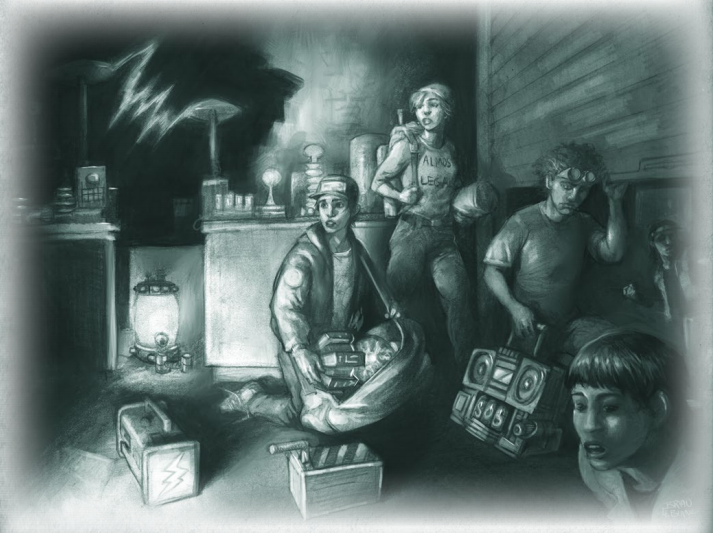
Escaped Government Experiments cast THREE MILLION illegal Votes for Hillary this Election! – NWoD Breitbart, probably
The other chief target for TMI is their creators and former tormentors, the actual Merrick group, who are still doing their sinister experiments for nefarious purposes we'll get to in the actual TMI writeup (which is, incidentally, shorter than this passage). This is ideologically important for TMI, both for purposes of protecting themselves and freeing the other test subjects still imprisoned by their old captors.
To find them, since all the official Merrick group's cells are self-contained, they scan the dreams of low-level employees who seem like they're being crushed by their working life:
quote:
There’s a certain kind of worker who is very qualified, often over-educated, and completely unsatisfied because they lack any real acknowledgement of what they’re doing (). They know they’re doing important work, they know they’re doing things that are changing the world, but they don’t know what they’re changing. There’s a depression that comes along with that. Every one of these people is like their own little Oppenheimer.
We find these people through their dreams, through their insecurities, and through their instabilities. We find them, we connect with them through dreams or online, and we challenge them. We show them possibility and potential. We peel back the curtain just enough that they want to come and tell us everything. Usually, we’re wrong. Usually, it’s just some wage slave dying one day at a time. But sometimes, we find the right track, and the desperate wage slave points us to a benign industrial park in a nondescript suburb. These kinds of places are like gold mines. Except instead of finding gold, you find motherfuckers who torture kids.
Seems like an extremely hit-and-miss tactic to me, and I'd be very surprised indeed if you found anything relevant that way, but whatever. The next task is to take the labs down, which involves going up against small but heavily-armed security units with “advanced weaponry, like some stuff you might expect on a Task Force: Valkyrie agent or something” (just so you know what to arm them with, STs
 ), and other experimentees who are still enslaved by Merrick proper and will defend the compound from dream attack. They try to sap the morale and combat effectiveness of the security teams by plaguing them with their dreams, but that would still leave a bunch of unfit teenagers and 20-somethings against a crack (but tired) team of very well-armed guards, so this still seems like a hiding to nothing to me. The most effective sounding tactic TMI uses in this situation is to get other Hunter teams to attack the compounds, because Merrick proper is a spooky supernatural high-tech government organisation and many Hunters would be fairly happy to help shoot up their labs, be it to save the kids, steal the tech, or both.
), and other experimentees who are still enslaved by Merrick proper and will defend the compound from dream attack. They try to sap the morale and combat effectiveness of the security teams by plaguing them with their dreams, but that would still leave a bunch of unfit teenagers and 20-somethings against a crack (but tired) team of very well-armed guards, so this still seems like a hiding to nothing to me. The most effective sounding tactic TMI uses in this situation is to get other Hunter teams to attack the compounds, because Merrick proper is a spooky supernatural high-tech government organisation and many Hunters would be fairly happy to help shoot up their labs, be it to save the kids, steal the tech, or both.Also Merrick labs have a habit of blowing up, sinking into the earth (!!!), or otherwise vanishing 48 hours after they get cleaned out, so you can't hang around in them for too long once you've taken out the people using them. Why?
 , and the book never really explains much about Merrick proper, so hell if I know the answer. TMI just focusses on liberating the prisoners and stealing as much sci-fi junk as they can before the place disappears (taking them with it, if they're still inside).
, and the book never really explains much about Merrick proper, so hell if I know the answer. TMI just focusses on liberating the prisoners and stealing as much sci-fi junk as they can before the place disappears (taking them with it, if they're still inside).Lastly there is a short section on other monsters. The Merrick Institute doesn't focus much on other monsters unless they think they're meddling in people's dreams. Sometimes they'll hunt changelings or mages in dreams, if that's what they think they're doing. But, while I don't know about changelings (since Changeling: the Lost Second Edition isn't out yet),* Mage's dream rules are pretty specific about how you can't actually kill a person by killing them in the Astral. So, while they could protect the dreams of others and fight off mages trying to invade or mess around with them, there isn't really a whole lot of damage they can do to a mage by killing her in dreams.
*It occurred sometime after I wrote this that the Changeling 2.0 playtest materials have been released, so I went and looked through those. Apparently Changeling dream combat does the same thing as dream combat as presented in this book, with damage you take in the dream persistent on waking, but downgraded by one category. So are mages special in that they don't take damage from dreams, or is this just rules contradiction? I personally think that damage from dream combat affecting your real-world body is a bit daft anyway, but 'what Onan thinks is daft' is not exactly a coherent design principle from which to mechanically critique a role-playing book, so.
They also hunt monsters in the real world, somewhat out of a sense of justice, somewhat because Beasts claim friendship with all the other monsters.
quote:
Besides, the Beasts of nightmare consider “real world” monsters to be family. If that’s not enough of a reason to fight them, I can't imagine what is.
Way to go, Beasts.
The Merrick Institute's writeup is very detail-heavy, but remarkably bare on why they're actually fighting Beasts, compared to the motivation-heavy Reckoning section. We'll find out, to a certain degree, what their deal is later on, but based on this part it seems like Merrick proper should be TMI's primary antagonist, not Beasts, and (spoilers) the actual TMI Compact writeup doesn't do much to change that impression. Why they hunt Beasts is almost an afterthought, but they do.
And that concludes tonight's episode of H:tVCaC:WDTK[AB]?DTKT?LFO!
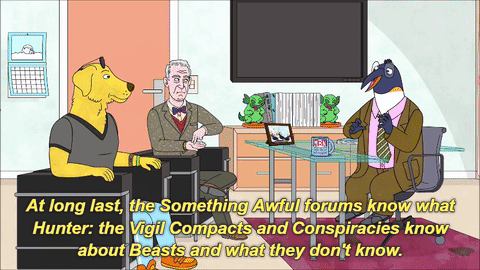
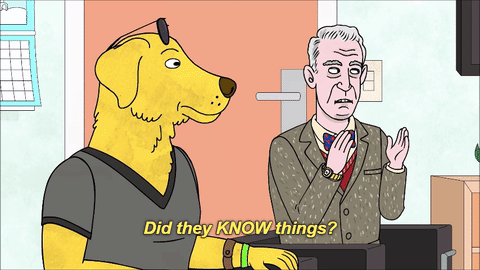
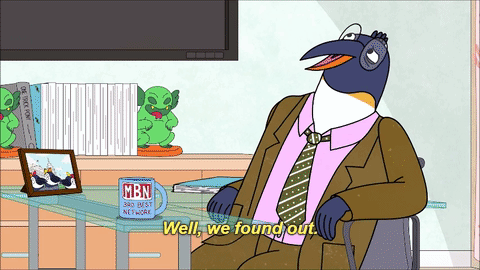
Next entry:
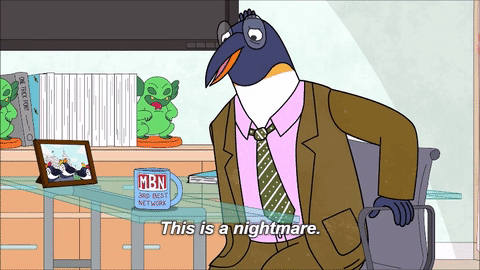
You said it, Pinky.
Crunch Part One, or; “My, What A Big Endowment You Have” Said The Actress To The Bishop
Original SA postI cannot contribute anything to Star Trek chat. Sorry 

Hunter: Tooth and Nail – Part Four: Crunch Part One, or; “My, What A Big Endowment You Have” Said The Actress To The Bishop
The next part of Tooth and Nail contains most of the actual mechanical stuff in the book. It has new Tactics, new Relics, and, like the other chapters of Mortal Remains, presents a simplified set of rules for creating your own Beasts and Heroes. But the first thing it contains is something that makes me realise I've been making a mistake in my discussion of this book this whole time, you guys.
It turns out that there aren't three Compacts in this book, as I'd thought, but two; Yuri's Group and the Reckoning. The Merrick Institute, stars of the last segment of my last entry in this review, are actually what Hunter calls a Conspiracy. In case you don't know NWoD/CoD's terminology, here's an explanation: Hunter: the Vigil was the first NWoD book to introduce a tiered organisational system to describe the scale on which supernatural organisations operate, one which later books in the line adopted. The system breaks all these organisations down into three tiers: tier one is operating on a purely local level – a suburb, a handful of city blocks, or a small town – like an individual cell of Hunters, pack of Werewolves, or coterie of Vampires; tier two is on a regional level, spanning a large city or wide geographic area, like a Consilium of Mages, a Freehold of Changelings, or a regional Hunter organisation like the Long Night. Tier three represents agencies and groups that operate on a national or global level (although global is sometimes its own tier in this system, tier four); most supernaturals aren't organised enough for this sort of scale, so there aren't that many examples other than Mage Orders and Ministries, massive Hunter Conspiracies, and possibly Vampire Covenants. Tier three groups are either extremely strong and influential in a given nation, have a truly global reach with bases and influence and agents all around the world, or both. In Hunter's terminology, tier one groups are cells, tier two groups are Compacts, and tier three groups are Conspiracies.
I needed to get all that out of the way so I can express my surprise at the Merrick Institute's status as a Conspiracy, not a Compact. Being a Conspiracy implies enormous reach and influence, spanning at least a large country or a region/group of smaller ones, and possibly extending, like the Malleus Maleficarum or the Cheiron Group, around the entire world. TMI... are not that. Their numbers are never stated but they don't come across as being all that high (I'd be surprised if we're meant to think there's more than fifty or sixty of them), they have no organisational structure, and while they stretch across a broad, undefined area of the United States, they have no great influence anywhere; no human agencies that unwittingly do their bidding, no quiet influence in any government departments, not even any real safe houses. If the book says they're a Conspiracy, they're a Conspiracy, but I get the feeling the authors only put them at that level because only Conspiracies get access to their own special powers, in the form of Endowments.
Endowments take as many forms as there are Conspiracies; they're not powers that come from a single source like Awakened Magic or Changeling Contracts, but various mystical or technological discoveries made and used exclusively by a given Conspiracy. Examples include the super-tech used by Task Force: Valkyrie, the alchemical elixirs of the Ascending Ones, or the Cheiron Group's supernatural organ implants. The Merrick Institute's Endowment is called “Dreamscape,” and it covers the powers that TMI operatives have to influence the dreaming world.
Dreamscape is three basic Merits from one to five dots in cost, and a few specialised Merits you can take when you've reached certain levels in those three basic Merits. The three basic ones are Dream Shield (it's Armour for the dream world, and some extra bonuses to resisting supernatural effects in dreams, going up with the amount of dots you invest in the Merit), Dream Sword (you can create an actual handheld melee weapon in dreams or project blasts like the Blast Numen; again, their damage rating goes up the more dots you have in this Merit), and Dream Shaping.
Dream Shaping is a lot like Spirit Influence; it gives one a certain amount of control over objects in the dream world, and the more dots you have in the Merit, the more you can do. The first-dot ability, Enhance, is basically the first-dot Influence ability, Strengthen. The two-dot ability is Deaden, which lets you do the opposite of Enhance (i.e. shrinking, weakening, or lessening things). Much like how you can't create new stuff with Enhance/Strengthen, you can't fully destroy anything with Deaden, only bring it down to almost nothing. The three-dot ability, Control, basically combines Manipulate and Control from the Influence list. The fourth-dot ability is Create, which is more-or-less the same as the spirit ability, and the five-dot ability is Destroy, which is like Deaden but you can go all the way and destroy an object or phenomenon in the dream world.
Dreamscape also gives access to seven derived Merits. They're all fairly simple in execution. Absorb and Fortify means you can siphon Durability/Structure from objects in the dream world and use them as temporary health boxes. Colossus means you can make really big objects with shaping. You've already seen Dreampushing; it means someone outside the dream world can manipulate things in dreams, although not terribly much. The book's guidance is “she cannot make physical attacks but has fine manipulation. Essentially, if it could be done with hands, but not arms, she can handle it.” You can also use your Dream Shaping from outside the dream world via this one, so it's clearly the best Merit. Regenerative Mind means you can regenerate Willpower spent specifically on Dreamscape abilities, and also do yourself bashing damage for more Willpower. Shielding Mind lets you confer your Dream Shield Merit on other people. Warp means you can use Dream Shaping as a reflexive action, and Wrack lets you use your Dream Sword to do damage to your opponent's Attributes.
There are also some dream-related Merits that any Hunter can take (possibly other characters as well). These are: Dream Avatar, a one-dot Merit you can buy as much as you like, which means you can add extra points to your attributes when you're in the dream world (cheap and very powerful if your campaign includes a lot of dream stuff; useless otherwise); Easy Out, Easy In, a four-dot Merit letting you spend a point of Willpower to reflexively leave a nightmare, or to quickly re-enter a nightmare you've left via the same method (seems like too high a cost to me for a Merit you then have to spend Willpower for every time you want to use it); Ephemeral Fetish, a dream memento of a real object now lost or destroyed, but once significant to the character, which can function as a very powerful protective object, weapon, and tool in dream space; and Dream Medic, a one-to-five-dot Merit which we covered earlier. It allows you to use real-world chemicals to heal dream damage or give a dreamer certain bonuses. I don't know how it's meant to work. Some of the bonuses make sense with certain drugs (giving someone a bunch of amphetamines probably would increase their Speed or Initiative in the dream world), but the healing bit is weird to me. Given that dream damage affects your physical body (still stupid to me), is someone using this Merit to heal dream damage patching up the wounds that appear on your real body when you take damage in dreams? And if that's so, why isn't this just a normal Medicine check? I'm aware there's no explanation needed as to the 'why' of what's happening, because this is a game about supernatural stuff and there doesn't need to be a rational explanation for everything, but some instructions on the 'what' and 'how' would be nice, because I can't even picture what's meant to be going on when this Merit is being used.
There are also a handful of new Endowments for other Conspiracies, specifically an Elixir for the Ascending Ones and three Relics for Aegis kai Doru. No weird organs for Cheiron, unfortunately 
The Elixir, Drop of Dreams, is just the one mentioned in the Ascending Ones' writeup in Part Three, the one that lets them visit the realm of primordial dreams. Nothing too exciting. It's a two-dot potion. You drink it, fall unconscious for a bit, and visit whatever ill-defined part of the Astral the Beasts live in. Dramatic failures attract the attention of Beasts and allow them to enter your dreams.
The first Relic entry, Dream Relic, is an add-on to an existing item rather than a Relic in and of itself. It represents a Relic that has been destroyed in the physical world and now only exists in dreams, and having the Merit means that that Relic, or a manifestation of it, has attached itself to your character's dreaming self, and now appears with you whenever your character is in a dream. Whether multiple people can be bonded to the same Relic in this way, or if a character can have the dream version of a Relic that still exists, is never specified. The Relic gains the same benefits as an ephemeral fetish (from the same Merit, above), and is also easier to activate; the character can choose to activate it by taking dream damage, as well, rather than just spending Willpower. It's an extra two dots on top of the Relic's normal cost.
Finally passing out of the realm of dreams, Actual Relic Number One is Perseus' Mirrored Shield, for three dots. By buffing the mirror and spending Willpower, it becomes a mirror that the Hunter can use to look at monsters. Looking at a monster via the mirror makes the Hunter immune to any Dread Powers it has, so long as those powers specifically target the character; an Exceptional Success on the roll also allows the Hunter to see the true form of any monster in the mirror's reflection. A Dramatic Failure means the Hunter thinks the shield's powers are working even though they're not, and fighting a monster while looking at it via the shield gives penalties to all relevant combat actions. Not bad to be immune to any directed powers, but if a creature just has super-strength, can set fire to the entire room you're in, or can otherwise attack you indirectly with its powers, you're still fucked. Also not much use if the vampire pulls a gun on you.
Perseus was almost the Greek archetype of a good, selfless, pious hero, not self-aggrandising like Theseus, temperamental like Herakles, or sacrilegious like Bellerophon. Having him show up here means the writers are associating him with the capital-H Heroes of Beast, theoretically meant to be selfish amoral arseholes, in a way that makes me, a Classical Studies student, quietly seethe. Moving on.
The second Relic is Saint George's Sword, for five dots. It's a Roman sword, old and somewhat blunt. It has a damage rating of 1L, gives a -1 penalty to hit, and any Dramatic Failures when activating it or hitting with it cause it to break. The sword itself reforms in a small market about a month after it breaks, but explicitly nowhere near you, the chump who just broke it. On the bright side, activating it properly and hitting a monster with it causes the monster to take one lethal damage per turn, which can only be stopped by killing the sword's wielder. Exceptional Success on activating it also makes its damage rating worth a damn and gives it Armour Piercing to boot. Using it against a human while activated causes the bleeding wounds to appear on the wielder, though (and there are no instructions on how to make this bleeding stop), so use with caution and possibly not against cultists or mages. A neat trick indeed if you can get it to work, but given the possibility of it shattering or inflicting terrible wounds on you if mistakenly used on a human, I'm not sure it's worth the five-dot rating.
The book also comes with four new Tactics. The first is Damsel in Distress, in which the primary actor pretends to be a perfect victim for the monster to lure it into striking distance, then hits it hard and in its most vulnerable point while the other actors appear to distract it so he can get away afterwards. This one's clearly meant for literal-predator-type monsters like vampires and Beasts, although the book seems to think you should use it on Heroes as well by pretending to be “someone to be 'saved.'” There's a significant dice penalty if the monster hasn't been lulled into a sense of security by the target first, as “monsters instinctively do not trust their prey,” but a single Manipulation + Persuasion roll removes the whole penalty, so it's not a big deal.
If it works, the primary actor gets extra successes in his dice pool, and can use the Killing Blow rules against the monster on his first turn. If it doesn't, he loses his Defence and the monster basically gets a free round of combat against him.
Going to Groups is the signature Tactic of Yuri's Group, and like them it's one of the more interesting things in a not-very-interesting book. It's basically group therapy for monsters to help them control their urges to feed/kill.
The primary actor in this case is the monster, again a predatory type like a Beast or a vampire. Unlike with the previous Tactic, Heroes are not called out as an example of something on which the Tactic could be used, even though trying to help Heroes overcome their compulsions is kind of a big thing for Yuri's Group. There's no reason you couldn't use this Tactic on them, though.
So the primary actor talks out their feelings and struggles, and the supporting actors listen and offer whatever support the primary actor needs. This includes “substitute meals,” and I'm not sure if that means the group are bringing a live chicken to every meeting with a vampire or if they're offering their own wrists to drink from, but either way it seems a bit counterproductive. Maybe they're just bringing along a microwave dinner as an alternative to live human blood?
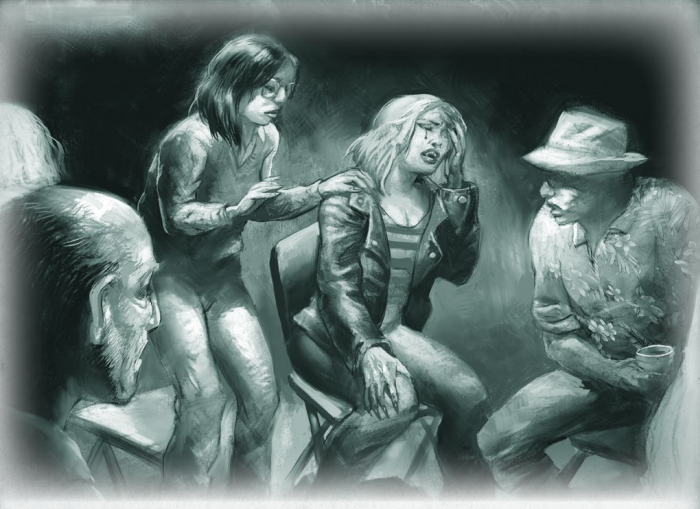
And then I woke up and I realised I was in a Beast supplement...
If the Tactic works, the primary actor loses the need to feed for about a week, and don't lose any Willpower/take any other ill effects for not feeding. She reduces any penalties that she might suffer for not feeding by 2, and can use the successes rolled when activating the Tactic for extra dice to resist the temptation to feed, on a one-for-one basis. However, if she gets down to one Willpower point, she takes a whopping -1 penalty to all her Physical Attributes, including derived traits. Also, she cannot kill, engage in brutality while feeding her hunger (if I'm reading it right, she can still feed, but presumably only consensually and in ways that don't cause harm, or perhaps just on animals), or regain Willpower through her Vice, or the effects end.
This process has to be repeated weekly, or else the primary actor will fall off the wagon. But if one goes on for long enough, she might be able to reduce or remove her hunger altogether:
quote:
With Storyteller discretion, this Tactic may result in a monster eventually shedding her hunger completely, and coming to terms with herself. This generally means she finds other sources of sustenance or can sustain herself on a minimal amount.
A hopeful note.
From a personal point of view; I have had one-on-one counselling (although never group therapy) often in the past for my fun, fun complex of depression, anxiety, and paranoia, and sometimes still have it now, and having the ability to talk out your problems with a willing and sympathetic ear really is great for keeping the demons at bay. None of what I have is really harmful to others, only myself, so it's not a one-to-one correlation, but I think that's probably one of the main reasons why I like the idea of this Tactic and Yuri's Group in general so much; the process of overcoming one's negative thoughts and impulses via social contact and the help and support of other human beings strikes a chord with me. Genuine life advice from an F&F review: if you're having mental health issues or harmful thoughts and impulses you can't deal with, chances are you're not alone, and it really does help to be able to reach out and talk to someone. It can be a counsellor, it can just be someone you know and trust. Personal note over, sorry for the digression.
I Need a Hero, the next Tactic, is the other thing that was discussed in Yuri's Group's writeup; goading a Beast into attacking with overwhelming force so as to draw a Hero into the fight. It's fairly self-explanatory; the actors draw the Beast into unleashing its full fury, and stay out of its way while it's raging, until a Hero can arrive to join the fight. It supposedly turns people who meet the requirements for Heroes, but are not yet Heroes, into Heroes. The Hero comes sooner or later depending on how densely peopled the area is. Fairly simple.
It's also apparently used by the Reckoning to create Heroes to kill. They think it draws Heroes, without realising that it actually turns people into them, so the Compact is creating its own victims. They're still very charming people, you see.
The last new Tactic is The Procedure. This one is how you get into the world of dreeeams, man, in the particular way that the Merrick Institute's hunters do it (i.e. with the primary actor entering the dream and the secondary actors monitoring the proceedings via computer from the outside), although Null Mysteriis and the Cheiron Group do it as well. The primary and secondary actors can assist each other in dealing with the dream world through their computer link, although teamwork actions are done at -2, as the two parties are seeing kind of different things; these teamwork actions can be taken by both the primary and secondary actors in the dream world, with either the primary actor doing stuff and the secondary actors pointing things out or assisting in minor ways via the Dreampushing Merit, or the secondary actors basically just telling the primary actor what to do and the primary actor doing it. The secondary actors can also pull the plug and yank the dreamer out of the dream world in an emergency. It's the puller's job from TMI's writeup last section, basically.
This Tactic can only be done with advanced equipment, like a fully-equipped lab or all the junk TMI regularly lug around. By the way, the writeup for the Tactic only says it can enter the primordial dream, the place where Beasts hang out, and not any other part of the Astral. So, as written, not useful for your Null Mysteriis group trying to explore the Temenos, sorry.
Incidentally, the “Organisations” section for this Tactic says that it's the signature Tactic, not of “the Merrick Institute,” but of “the Dream Warriors.” So I think TMI really was called the Dream Warriors in an early draft of this book, a name slightly less bland and considerably more cheesy. Also taken from a Nightmare on Elm Street sequel, I believe. Kind of sad they didn't use it; it's a way better name than what they ended up with.
Next time: Crunch part two – the rules for making Beasts and Heroes. Spoiler alert; Heroes kind of get the shaft.